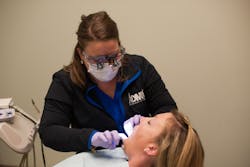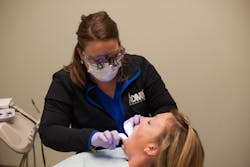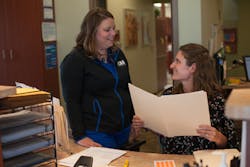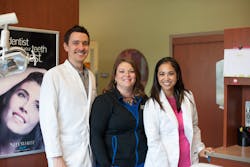Proud of My Op: Working on an accelerated schedule and loving every minute
Amanda Apple, LDH, BGS, has worked for Dr. Kurt Losier and Dr. Jennifer Sitjar at the Warsaw, Indiana, Aspen Dental since it opened in December 2011. “We work together from a collaborative approach to bring patients a comprehensive dental plan,” she says. Within the last year, “we turned two units into a hygiene bay and we now run an accelerated hygiene schedule out of the two side-by-side units.”
Amanda performs an exam on a patient.
Though it was a big change, she says she loves everything about the new schedule, and it’s also impacted her operatory as well. One of the new features that both she and her patients love is dual monitors. “We have two screens in each room: one connected to our desktop and one connected to the light pole. This setup allows us to switch input options to cable TV or computer if we want to display a perio chart, x-rays, or any other patient education tools. We also use an on-screen translating function to communicate with our patients who speak English as a second language.” In addition, the hygiene operatory has moved away from the “hustle and bustle of the main clinic, so it’s a bit quieter also,” helping patients to relax.
Amanda’s new operatory has some tools that she loves, too, especially her Hu-Friedy Air-Flow air polishing unit. “It’s a higher quality biofilm removal process and is easy and quick. I still use disclosing solution, and you can see the air polisher removing the biofilm at the margin without some of the side effects of traditional polishing, even with fine paste.
Amanda shows off her loupes.
“I especially love it for my orthodontic patients. I never felt great about biofilm removal around brackets, and now it’s a must when they are in the office. It gives me an opportunity to spend more time on patient education as well,” she explains. The practice also added Kodak digital imaging to the operatory: “I like being able to show patients their teeth, and manipulating the films is a great educational tool,” she says.
She’s also made a couple of important ergonomic additions to the operatory herself. “My loupes were a preventive step [for my health]. I wear Orascoptic Elite RDH in my favorite color, purple! As for my Crown Seating saddle stool, I had worked in an office shortly after graduation that had them, and I loved it. At the time, I couldn’t afford to spend the money, but when I started in the Warsaw office, I saved up and was able to purchase one. I did not realize until after I bought it how much of a necessity it was. I have a hard time sitting in a ‘normal’ operator chair now!”
What about one of the biggest changes to her operatory, the accelerated hygiene schedule? As we mentioned above, Amanda says that she really enjoys this new way to practice. “[I work] with other dental hygienists to expand my knowledge and skill set—I worked as a single provider for seven years, and that was great because they were my patients, but it gave me an inflated sense of self. Adding a second hygienist expanded the knowledge in the clinic threefold: mine, hers, and ours. Being able to bounce ideas, treatment plan options, and reinforce the importance of dental care from an added provider is a huge asset,” she explained.
The new hygiene schedule requires a close relationship between the hygiene department and the front desk.
“Having accelerated hygiene allows you to take emergency/walk-in patients and patients who want to start care the same day. This is a challenge because you never truly know what your schedule is going to look like and you don’t see a set schedule of patients per day. I personally like that (two providers, two different focuses during the therapy portion of the appointment), but sometimes it is nice to know what the day is going to look like! You also have to learn to give up control of your schedule (to some degree), and that’s not always easy for us!”
But the transition has not come without its difficulties. “Learning when to say ‘no’ also becomes more of a challenge. Dental hygienists are heavily dependent upon a dentist to practice, and when I am in an office from 9:00 to 6:00, I want to provide as much high-quality care as I can, which means it’s difficult for me to say ‘No, I can’t see that patient today.’ Patients don’t have the option to have care outside normal business hours like they do in other health-care industries, and because of that and our dependence on the dentist, I [really want] to say yes as much as possible. Realizing that sometimes, you just can’t do it is always a struggle—especially with two hygienists.”
Amanda with her colleagues Dr. Kurt Losier and Dr. Jennifer Sitjar.
What’s Amanda up to when she’s not at work? “I am married and have two children,” she told us. “We are a baseball-loving family, and I enjoy reading. I am very involved in the Indiana Dental Hygienists’ Association and am a strong advocate for membership in ADHA—#gamechangerswanted. I can say without a doubt, membership and active participation in the Association is 50% of what has pushed me to be the dental hygienist I am today. The other 50% is a solid partnership with my doctors.”




